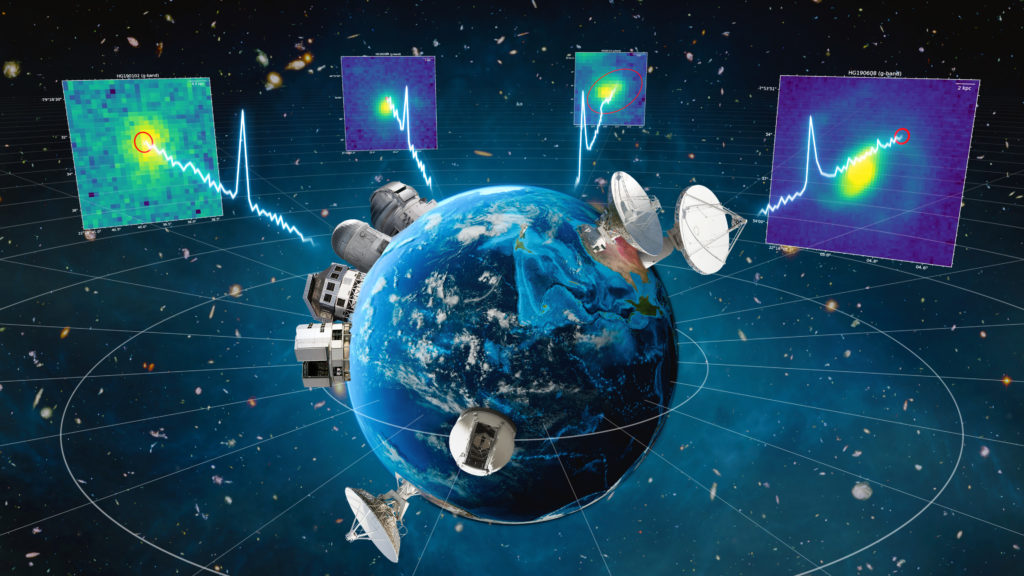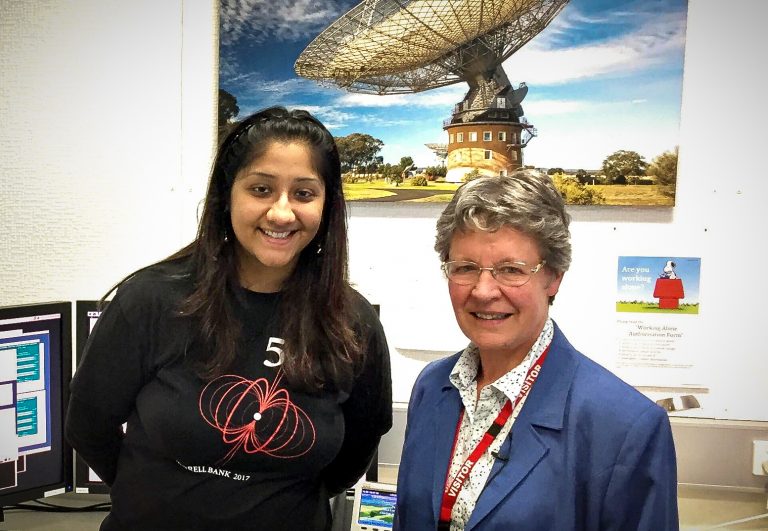
Our ASKAP radio telescope in Western Australia has detected the precise location of four fast radio bursts. Image: Sam Moorfield.
Imagine you’re part of a team working to solve today’s biggest mystery in astronomy. Well, our very own Dr Shivani Bhandari is on that team and she just led a recent breakthrough.
The team is the Australian Square Kilometre Array Pathfinder (ASKAP) CRAFT survey science team. And they’ve been investigating the phenomenon known as fast radio bursts.
Professor Duncan Lorimer from West Virginia University first discovered fast radio bursts in 2007. It was an unexpected discovery while he was analysing data from our Parkes radio telescope (aka ‘The Dish’).
Fast radio bursts are brief explosions in the distant Universe. They are extremely bright. They release more energy in a millisecond than our Sun emits in 80 years. See video below for a visual explainer.
Fast radio bursts are the hottest topic in astronomy. These bright bursts baffle researchers. But they’re pretty sure whatever is causing them is associated with an extreme astrophysical environment. The hunt is on to solve this cosmic mystery.
ASKAP pinpoints location of one-off radio burst 4 billion light years away.
Neighourhood galaxy watch
ASKAP is a survey telescope, based in remote Western Australia. And to date it has revealed some vital clues about fast radio bursts. In 2017, it detected its first fast radio burst after just eight hours of searching. Then in 2018, it found 20 more, almost doubling the number of known bursts. And then in 2019, it traced a fast radio burst to its originating galaxy six billion light years from Earth.
Now, this is where Shivani’s research comes in. Using a specially designed detector on ASKAP, Shivani and her team found the exact location of four new fast radio bursts.
Then astronomers conducted follow-up observations with the world’s largest optical telescopes. Shivani used these images to study the neighbourhood surrounding each burst, providing clues about their origins.
“I wanted to see if there were any patterns in the sort of galaxies that host fast radio bursts. Similarities between their neighbourhoods could suggest a common cause,” Shivani said.
Pieces of the puzzle
Shivani’s research is the first detailed study of the galaxies that host fast radio bursts. It rules out several of the more extreme theories put forward to explain their origins.
“The precisely localised fast radio bursts came from the outskirts of their home galaxies. This removes the possibility they have anything to do with supermassive black holes,” Shivani said.
Even more surprising, the astronomers found all four bursts came from massive galaxies with modest star-forming rates. Very similar to our own Milky Way galaxy.
This means the CRAFT team has also ruled out other theories like extremely bright exploding stars and cosmic strings. Other ideas like collisions of compact stars, such as white dwarfs and neutron stars are still looking good.
Glowing commendations
Dame Jocelyn Bell Burnell was a postgraduate student in 1967 when she first detected rapidly spinning neutron stars now known as ‘pulsars’. Now a legend in international astronomy, Dame Jocelyn praised Shivani’s research.
“Positioning the sources of fast radio bursts is a huge technical achievement and moves the field on enormously,” Dame Jocelyn said.
“We may not yet be clear exactly what is going on, but now, at last, options are being ruled out.”

Pioneer of pulsars Dame Jocelyn Bell-Burnell (right) and Dr Shivani Bhandari (left) in 2018.
Shivani and the ASKAP CRAFT team continue to lead the world in identifying the location of fast radio bursts. Finding and localising more bursts will lead to a better understanding of their galaxy hosts. And ultimately solve the mystery of what causes them.
Our ASKAP radio telescope at the Murchison Radio-astronomy Observatory (MRO) in Western Australia. CSIRO acknowledges the Wajarri Yamaji as the traditional owners of the MRO site.
We were saddened to hear the news of the passing of Associate Professor Jean-Pierre Macquart this week. The CRAFT project team is a large collaboration which has been led by three Principal Investigators since 2016, including Jean-Pierre. He led the proposal to undertake fast radio burst research with ASKAP and developed the mathematical tools to understand the demographics of the fast radio burst population. His most recent work using fast radio bursts to find the missing matter in the Universe was published in Nature on 28 May 2020. Jean-Pierre will be remembered as an exceptional scientist with a satirical sense of humour and a passion and excitement for his work. Our thoughts are with his family, many friends and colleagues. Curtin University will hold a memorial for Jean-Pierre at a future date.


26th June 2020 at 1:44 pm
Simple question. Deep down what do you think it is?
13th June 2020 at 10:00 am
Fascinating and marvellous! Well done Dr Shivani Bhandari and her team. Great to see praise from the one and only Jocelyn Bell.
Might those cosmic events also produce gravitational waves?
18th June 2020 at 10:37 am
Hi John, thanks for your question. We reached out to Dr Bhandari for a response and she let us know “We haven’t found any FRBs simultaneous with gravitational wave detections so far. Our work suggests that merging compact objects (such as neutron stars) is one of the favourable FRB models, which could produce a gravitational wave. If we detect a gravitational wave accompanying an FRB, it would be a big breakthrough in our understanding of the sources of FRBs.”
We hope this helps!
Thanks,
Georgia
Team CSIRO
12th June 2020 at 6:43 pm
So good to know people continue to seek answers to such puzzles when so many lesser minds disdain any curiosity that they can’t see direct linking to their own hip pocket.